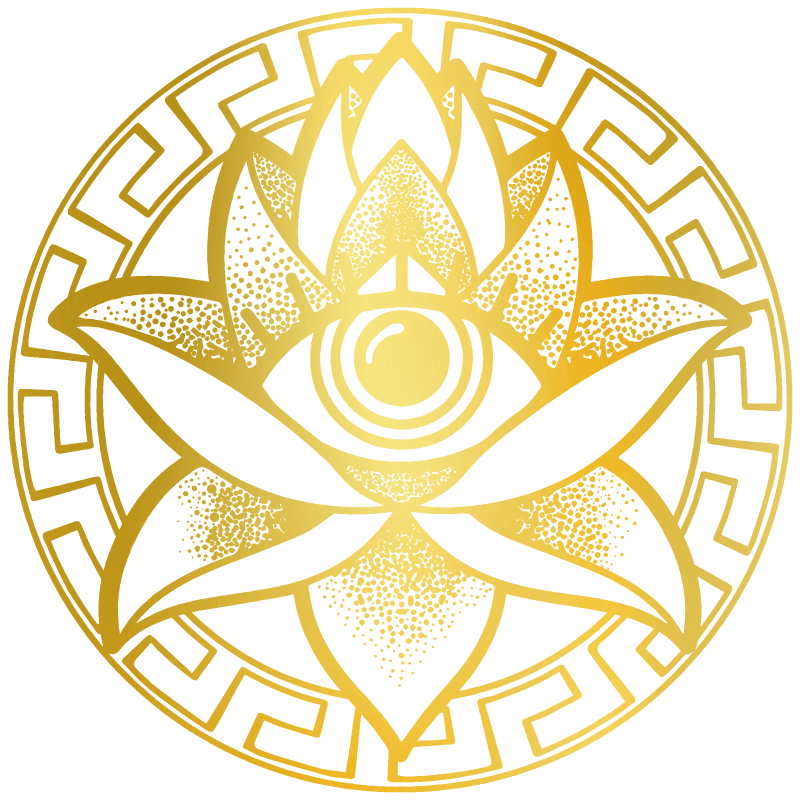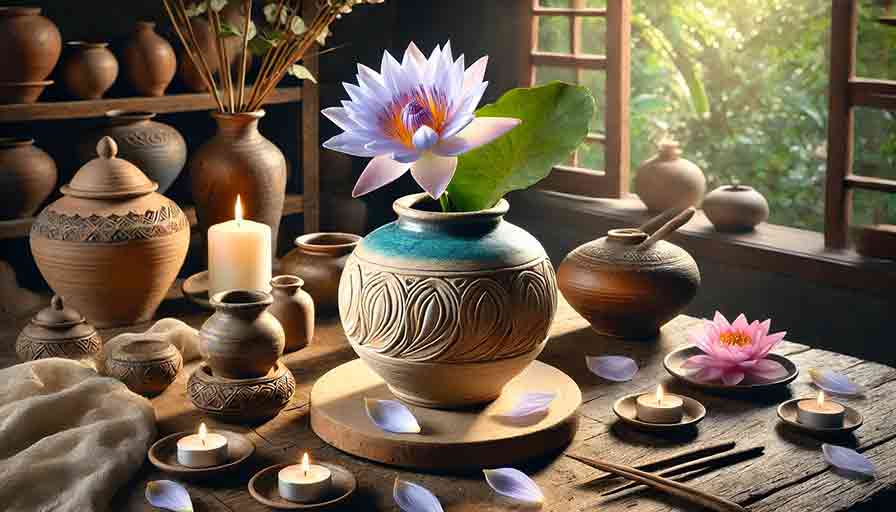The Blue Lotus (Nymphaea caerulea)—also known as the Egyptian Blue Water Lily—has enchanted artists, artisans, and spiritual seekers for thousands of years. Revered in ancient Egypt and admired across Asia and Europe, its distinctive blue petals and ethereal symbolism have inspired countless pottery designs, artworks, and decorative motifs. Beyond its visual allure, the Blue Lotus holds cultural, spiritual, and aesthetic importance that continues to shape modern art and design.
The Timeless Symbolism of the Blue Lotus
The Blue Lotus symbolizes rebirth, transcendence, and enlightenment, primarily due to its natural rhythm—it blooms with the sunrise and closes at dusk. Ancient Egyptians saw it as a sacred emblem of spiritual awakening and divine connection, representing the soul’s journey from darkness into light. This symbolism has carried forward through millennia, influencing visual expression in both traditional and contemporary decorative arts.
In pottery and ceramics, the Blue Lotus often appears as a motif symbolizing purity, serenity, and immortality. Artists use its imagery to invoke balance and introspection, blending aesthetic beauty with deep philosophical meaning.
Historical Influence of Blue Lotus in Ancient Art
Egyptian Ceramics and Tomb Decorations
Archaeological discoveries reveal Blue Lotus motifs etched, painted, and glazed on pottery dating back over 3,000 years. In ancient Egypt, artisans crafted jars, vases, and ceremonial cups adorned with lotus patterns—especially those used in religious rituals and burial offerings. The recurring depiction of the Blue Lotus alongside the sun god Ra and deities like Nefertem symbolizes life, fertility, and divine creation.
These artifacts not only served decorative purposes but also held ritualistic significance, often placed in tombs to accompany the deceased into the afterlife. The Blue Lotus thus transcended decoration—it became a bridge between the earthly and spiritual realms.
The Blue Lotus in Classical and Asian Decorative Arts
Greek and Roman Adoption
Through ancient trade, the Blue Lotus traveled from the Nile to the Mediterranean. Greek and Roman artisans adopted its motif in mosaics, frescoes, and terracotta pottery, integrating Egyptian symbolism with their own aesthetic traditions. The lotus’s serene form complemented Hellenistic ideals of harmony and proportion, becoming a recurring design in temple reliefs, amphorae, and household ceramics.
Asian Art and Symbolism
Though distinct from the Indian sacred lotus (Nelumbo nucifera), the Blue Lotus’s visual similarity led to its integration into Buddhist and Hindu art. In these traditions, it represents wisdom and spiritual awakening, often depicted beneath divine figures or floating above water in paintings, sculptures, and porcelain works. The motif became a cross-cultural icon, linking art forms from Egypt to Asia through a shared language of symbolism and serenity.
Modern Applications of Blue Lotus in Pottery and Decor
Revival in Contemporary Ceramics
Today’s potters are rediscovering the Blue Lotus as a motif that merges ancient mystique with modern design. Contemporary ceramic artists handcraft vases, bowls, and tiles featuring lotus-inspired carvings and glazes in tranquil shades of cobalt blue, turquoise, and ivory. These creations evoke spiritual calmness while maintaining functionality and modern minimalism.
Designers often use textured imprints of Blue Lotus petals, raised relief patterns, or subtle lotus silhouettes in glazes. The result is a sophisticated blend of heritage and innovation—perfect for interior settings that favor boho-chic, Zen, or Egyptian revival styles.
Blue Lotus as a Decorative Design Element
In Home Interiors
In interior design, the Blue Lotus motif is a statement of elegance and mindfulness. It appears in wall art, sculptural ceramics, textiles, and glasswork, where its soft hues and symbolic aura create a serene ambiance. Incorporating lotus-themed pottery or wall decor into spaces such as living rooms, meditation corners, or spa environments adds a sense of tranquility and spiritual depth.
In Jewelry and Ornamentation
Beyond pottery, the Blue Lotus also flourishes in the world of decorative jewelry and fine art sculptures. Craftsmen design pendants, mosaics, and embossed metalworks inspired by its distinct petal structure. The color blue—associated with intuition and peace—enhances the lotus’s charm, making it a powerful symbol of beauty and awareness in both wearable and ornamental art.
Artistic Techniques Used in Blue Lotus Pottery
Hand-Painting and Glazing
The hand-painting of Blue Lotus designs requires exceptional precision. Artisans use natural pigments, often rich in cobalt, to create deep blue hues reminiscent of the original flower. Glazing techniques vary—some prefer matte finishes to highlight organic textures, while others use high-gloss coatings for a luxurious shine.
Engraving and Relief Work
Engraved Blue Lotus motifs, particularly in stoneware and porcelain, bring tactile depth to pottery. Raised lotus forms cast subtle shadows under soft lighting, creating a visual interplay between light, texture, and symbolism. These artistic details reflect not only craftsmanship but also the enduring fascination with nature’s geometry and spiritual beauty.
Cultural Renaissance of Blue Lotus Art
The revival of ancient aesthetics has spurred new interest in the Blue Lotus among modern artists and collectors. This resurgence parallels the growing global appreciation for sustainable art practices and cultural storytelling. Artisans are returning to natural glazes, eco-friendly materials, and traditional motifs to celebrate both heritage and sustainability.
Galleries and museums now showcase Blue Lotus pottery and art as part of exhibitions exploring ancient Egyptian symbolism and nature-inspired design. The motif serves as a visual reminder of humanity’s ongoing dialogue with spirituality, art, and the environment.
Blue Lotus as a Symbol of Artistic Rebirth
The Blue Lotus continues to inspire artists not only for its beauty but for what it represents—the awakening of creativity and consciousness. In a world increasingly dominated by industrial design, lotus-inspired pottery brings back the essence of handcrafted authenticity. Each piece tells a story of renewal, reminding both artist and observer that art, like the lotus, can rise gracefully from still waters to bloom again.
Collecting and Displaying Blue Lotus Pottery
Collectors value Blue Lotus pottery for its historical resonance and visual sophistication. When displaying such pieces, consider environments that complement their symbolism—light-filled spaces, natural textures, and minimalist surroundings. A Blue Lotus vase on a wooden table or a ceramic plate mounted against a white wall can transform an ordinary space into a sanctuary of reflection and grace.
Conclusion
The legacy of the Blue Lotus in pottery, art, and decorative design endures as a celebration of both nature and spirit. From the sands of ancient Egypt to modern art studios, it remains a symbol of purity, balance, and creative enlightenment. Its soft blue petals remind us that beauty and wisdom often emerge from stillness—just as the lotus rises from calm waters to meet the sun.
As artists continue to reinterpret this timeless emblem, the Blue Lotus proves that true inspiration, like its bloom, is eternal.
Frequently Asked Questions
1. What does the Blue Lotus symbolize in art and pottery?
The Blue Lotus represents spiritual awakening, purity, and rebirth. In ancient Egyptian art, it symbolized the rising sun and the soul’s journey toward enlightenment, making it a common motif in religious and decorative pottery.
2. How is the Blue Lotus used in modern pottery and home décor?
Modern artists use Blue Lotus motifs in pottery, wall art, and interior décor to evoke tranquility and balance. Its elegant form and calming blue tones fit well in bohemian, minimalist, and Zen-inspired spaces.
3. What materials and techniques are used to create Blue Lotus pottery?
Artisans often use hand-painting, engraving, and glazing techniques to craft Blue Lotus pottery. Common materials include porcelain, earthenware, and stoneware, finished with cobalt-blue or turquoise glazes to mirror the flower’s natural beauty.
4. Is Blue Lotus design inspired only by Egyptian culture?
While ancient Egypt is the origin of the Blue Lotus motif, its symbolism spread across Greece, Rome, and Asia, where it merged with local traditions and spiritual themes, making it a global icon of artistic serenity.
5. Why is Blue Lotus pottery popular among collectors today?
Collectors admire Blue Lotus pottery for its aesthetic charm, historical value, and spiritual depth. Each piece connects the ancient past with contemporary artistry, making it both a meaningful and visually captivating addition to any collection.

